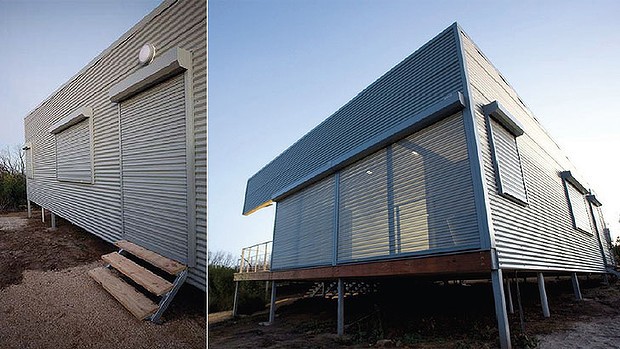H House by Ian Weir Architect can sustain itself in a bushfire, presenting a model for reconciling fire protection and diversity with daily life.
Bushfires are devastating; an occurrence that cannot be completely prevented, but one that we can try to safeguard against.
For instance, in 2009 after the Black Saturday Bushfires, the Victorian Government launched an online catalogue of house blueprints that promoted bushfire-resistant designs. Models from 19 practices that comply with the bushfire building codes and embody sustainable principles were selected for the free architectural service, which aimed to help people rebuild the 2,000 homes lost in the fires.
The same year saw Ian Weir Architect present a house that can sustain itself in a bushfire without human intervention. Led by research architect and Queensland University of Technology (QUT) lecturer Dr Ian Weir, H House presents a model for reconciling bushfire and diversity with daily life.
Built for a family of five, the house is located in the bushfire prone biodiverse landscape of Point Henry, Western Australia. According to Dr Weir’s website, the house was not designed to be a bushfire resistant house per se, but to be a place that would situate the owners in close proximity to the diverse health vegetation of the site.
However, being able to defend itself from bushfires means its residents can keep the surrounding vegetation intact instead of having to clear it away. This goes against the common (and official) advice of keeping the 40 metres around a home free from bark, dry grass and debris.
“I’m fundamentally not interested in clearing vegetation just to achieve bushfire safety, because there are a lot of problems with that approach other than just taking away the nice trees. There’s no actual guarantee that that will actually protect your house,” Dr Weir said to WA Today.

Shying away from a “top-down” culture that discourages homeowners from preparing for the worst by designing the right kind of house from the outset, H House is developed using a “ground up” approach which followed a detailed topographical survey by Dr Weir.
He also collaborated with a local botanist and bushfire risk consultant to ascertain the level of threat that fire presented to the site.
A number of design strategies have been implemented to prevent a structural fire occurring within the house during a bushfire, including the installation of windows made of double glazed fire resistant glass, some of which are protected by CSIRO-tested perforated roller shutters.
Activated remotely from up to 100 metres away, these fire shutters are the main defense against ember attack and radiant heat. They also control sun penetration, light levels and glare, insects and wind in the day to day.
This not only minimises additional costs associated with ‘fire protection’, but allows the behaviour of residents in emergencies to be closely aligned with their daily patterns of habitation.

Having a simple exterior geometry was also important for Dr Weir, and H House does not have conventional eaves or verandahs. It is built on structural steel stumps, some which extend all the way through to the roof.
The timber floor is suspended and protected from fire by fibre cement sheeting. The sun control requirements related to BCA energy efficiency ratings (4 Star in 2006) were met by factoring in the shutters, which are located on the northern and eastern facades.
Other initiatives include a roof that is fully cladded using fire-resistant FRC sheeting, and which has no ridges or valleys – especially important to prevent embers from getting caught. Sprinklers protect the timber decks, while a safety zone inside the house has dedicated fire fighting and safety equipment in it.

“[These features] are intended to stop a structural fire happening within the house. It’s not intended to be in perfect condition after a fire,” said Dr Weir, who has previously stressed to BPN Magazine that houses are not destroyed by bushfires, but house fires, although there is a direct correlation between the two.
“Rather than seeing buildings as merely a means of mitigating a threat through technical knowhow, [H House] suggests how bushfire itself might be viewed as a means of advancing architecture’s contribution to Australia’s cultural expression.”
Images: Andrew Halsall. Source: WA Today

